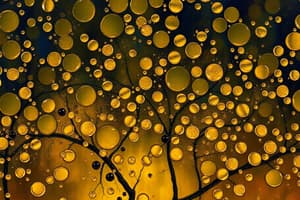Podcast
Questions and Answers
What is the primary characteristic that distinguishes saturated fatty acids from unsaturated fatty acids?
What is the primary characteristic that distinguishes saturated fatty acids from unsaturated fatty acids?
- Saturated fatty acids are only found in vegetable oils.
- Saturated fatty acids have higher melting points due to stronger intermolecular interactions. (correct)
- Saturated fatty acids have double bonds in their molecular structure.
- Saturated fatty acids contain more carbon atoms.
Which statement accurately describes the solubility of simple lipids in water?
Which statement accurately describes the solubility of simple lipids in water?
- Simple lipids are highly soluble in water.
- Simple lipids form emulsions in water.
- Simple lipids are completely miscible with water.
- Simple lipids are insoluble in water but soluble in organic solvents. (correct)
What causes the lower melting point of unsaturated fatty acids compared to saturated fatty acids?
What causes the lower melting point of unsaturated fatty acids compared to saturated fatty acids?
- Unsaturated fatty acids are more polar than saturated fatty acids.
- Unsaturated fatty acids have a linear shape.
- The geometry of double bonds introduces bends that weaken intermolecular interactions. (correct)
- Unsaturated fatty acids contain fewer carbon atoms.
Which type of lipids are primarily found in vegetable oils?
Which type of lipids are primarily found in vegetable oils?
What is the process called that converts unsaturated fatty acids into saturated fatty acids?
What is the process called that converts unsaturated fatty acids into saturated fatty acids?
What is the main structural feature of triacylglycerol?
What is the main structural feature of triacylglycerol?
What is the primary product of acidic hydrolysis of triacylglycerol (TAG)?
What is the primary product of acidic hydrolysis of triacylglycerol (TAG)?
Which configuration is almost always present in natural fatty acids?
Which configuration is almost always present in natural fatty acids?
Which type of rancidity is primarily caused by hydrolysis of fat due to bacterial contamination?
Which type of rancidity is primarily caused by hydrolysis of fat due to bacterial contamination?
What is rancidity primarily related to in the context of lipids?
What is rancidity primarily related to in the context of lipids?
What facilitates the emulsification of oily materials during alkaline hydrolysis of triacylglycerol?
What facilitates the emulsification of oily materials during alkaline hydrolysis of triacylglycerol?
How does oxidative rancidity affect unsaturated fats?
How does oxidative rancidity affect unsaturated fats?
Which of the following is a consequence of rancidity in fats?
Which of the following is a consequence of rancidity in fats?
What is produced during the enzymatic hydrolysis of triacylglycerol?
What is produced during the enzymatic hydrolysis of triacylglycerol?
Which factor contributes the most to the rancidity of unsaturated fats?
Which factor contributes the most to the rancidity of unsaturated fats?
Which of the following best describes hydrolysis in the context of triacylglycerol?
Which of the following best describes hydrolysis in the context of triacylglycerol?
Flashcards are hidden until you start studying
Study Notes
Lipids: Introduction
- Lipids are a diverse group of organic compounds, with diverse structures and functions in living organisms.
- Lipids play crucial roles in cell structure, energy storage, and signaling pathways.
Lipids: General Classification
- Simple Lipids: Esters of fatty acids with alcohols.
- Fats: Solid simple lipids at room temperature.
- Oils: Liquid simple lipids at room temperature.
- Compound Lipids: Lipids molecules containing other components in addition to fatty acids and alcohols.
- Derived Lipids: Substances derived from simple and compound lipids by hydrolysis - examples include fatty acids, steroids, and glycerols.
Fatty Acids: Classification and Characteristics
- Fatty acids are long-chain carboxylic acids with a polar head (carboxylic acid group) and a non-polar tail (hydrocarbon chain).
- Saturated Fatty Acids (SFAs): Contain only single bonds in their hydrocarbon chains.
- Unsaturated Fatty Acids (USFAs): Contain one or more double bonds in their hydrocarbon chains.
Triacylglycerol (TAG): Structure and Properties
- TAG consists of glycerol (a three-carbon alcohol) esterified with three fatty acids.
- TAG is crucial for energy storage and insulation in the body.
- TAG is the most abundant type of lipid in animals and plants.
Physical Properties of Simple Lipids (TAG)
- Solid at room temperature: Fats - typically from animal sources, such as butter and lard.
- Liquid at room temperature: Oils - typically from plant sources, such as olive oil and sunflower oil.
- Solubility: Simple lipids are soluble in organic solvents like chloroform, ether, and benzene. They are relatively insoluble in water.
Melting Point of Fatty Acids
- Saturated Fatty Acids: Higher melting points due to the close packing of molecules (stronger intermolecular interactions) caused by the absence of double bonds.
- Unsaturated Fatty Acids: Lower melting points due to "bends" in the molecule caused by double bonds, which weaken intermolecular interactions.
Chemical Properties of Triacylglycerol (TAG)
- Hardening: Process of converting liquid oils into solid fats by adding hydrogen to the double bonds of USFAs.
- Hydrolysis: Breaking down TAG into glycerol and fatty acids.
- Acidic Hydrolysis: Using dilute acids (e.g., HCl).
- Enzymatic Hydrolysis: Using lipase enzymes.
- Alkaline Hydrolysis (Saponification): Using alkali (e.g., KOH) to produce glycerol and soap (salts of fatty acids).
Rancidity: Definition, Causes, Types, and Hazards
- Definition: Deterioration of fat or oil, leading to unpleasant odors, tastes, and changes in color.
- Causes: Exposure to oxygen, light, heat, and moisture.
- Types:
- Hydrolytic Rancidity: Decomposition of TAG by lipase enzyme, leading to the release of free fatty acids and glycerol.
- Oxidative Rancidity: Oxidation of unsaturated fatty acids by oxygen, generating peroxides, aldehydes, ketones, and dicarboxylic acids.
- Hazards:
- Toxicity: Rancidity products can be toxic, causing food poisoning and potential health problems.
- Nutrition Loss: Rancidity destroys fat-soluble vitamins (A, D, K, and E) and polyunsaturated essential fatty acids.
- Economic Loss: Rancid fats are inedible and lead to economic losses.
Prevention of Rancidity
- Store fats and oils in a cool, dark, and dry place.
- Limit exposure to air and moisture.
- Use antioxidants to prevent oxidation.
- Use proper packaging materials.
Studying That Suits You
Use AI to generate personalized quizzes and flashcards to suit your learning preferences.




